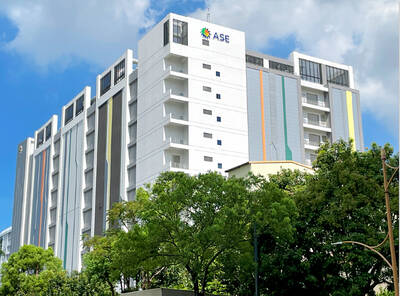Kwang Yang Motor Co (光陽工業), which sells its products under the brandname KYMCO, yesterday unveiled a new electric sport scooter, dubbed F9, to target eco-conscious riders.
The F9 is the first electric scooter designed by the company from scratch, it said.
The nation’s biggest manufacturer of gas-powered scooters, Kwang Yang ventured into electric scooters about three years ago by remaking its gas-powered “Many” and “Nice” series into electric ones. At the time, the focus was mostly on its battery charging system, called Ionex.

Photo: Lisa Wang, Taipei Times
“KYMCO’s all-new F9 model offers not only urban mobility, but also satisfies riders’ desire for a better steering experience,” company chairman Allen Ko (柯勝峰) told a global conference in Taipei.
The one-seat electric scooter performs better than a 150cc scooter, the company said, adding that most electric scooters sold on the local market are 125cc models, including those from Gogoro Inc (睿能創意).
The F9 is scheduled to hit the market next year, the company said.
Another electric motorcycle model, called RevoNEX, is to enter mass production at a factory in Italy, it added. Kwang Yang unveiled the concept vehicle at the Milan Motorcycle Show last year, targeting the global electric motorcycle market.
Aside from those two high-performance electric two-wheelers, Kwang Yang CEO Ko Chun-ping (柯俊斌) said the company is to roll out new electric scooters for the mainstream market in the near future.
The company also unveiled two new gas-powered motorcycles and one gas-powered scooter.
Thanks to tax incentives and purchase subsidies, Kwang Yang expects the domestic scooter market to rise 12.2 percent year-on-year to hit a 25-year high of 1.01 million units this year.
The COVID-19 outbreak has also stimulated demand, as people try to avoid mass transportation to reduce risks of contracting the virus, the company said.
“Government tax incentives and subsidies are the biggest drivers behind the growth,” Ko said. “Our shipments are capped by limited capacity. This year’s growth has greatly exceeded our expectations.”
As the Environmental Protection Administration is to stop subsidies for gas-powered scooters that meet its Phase 7 emissions standards from January, Ko said that scooter sales are expected to shrink by between 5 and 10 percent to between 900,000 and 950,000 units next year.
Kwang Yang expects its market share to climb to 34 percent this year from last year’s 33.4 percent, with total sales reaching 350,000 units.
Separately, Gogoro yesterday announced that China Motor Corp (中華汽車) is to join the “Powered by Gogoro Network,” making it the fifth member of the network.
Starting next year, China Motor is to offer new electric scooters under the company’s “eMoving” series that are equipped with batteries that riders can either recharge or swap for new ones.

AI BOOST: Although Taiwan’s reliance on Chinese rare earth elements is limited, it could face indirect impacts from supply issues and price volatility, an economist said DBS Bank Ltd (星展銀行) has sharply raised its forecast for Taiwan’s economic growth this year to 5.6 percent, citing stronger-than-expected exports and investment linked to artificial intelligence (AI), as it said that the current momentum could peak soon. The acceleration of the global AI race has fueled a surge in Taiwan’s AI-related capital spending and exports of information and communications technology (ICT) products, which have been key drivers of growth this year. “We have revised our GDP forecast for Taiwan upward to 5.6 percent from 4 percent, an upgrade that mainly reflects stronger-than-expected AI-related exports and investment in the third

Mercuries Life Insurance Co (三商美邦人壽) shares surged to a seven-month high this week after local media reported that E.Sun Financial Holding Co (玉山金控) had outbid CTBC Financial Holding Co (中信金控) in the financially strained insurer’s ongoing sale process. Shares of the mid-sized life insurer climbed 5.8 percent this week to NT$6.72, extending a nearly 18 percent rally over the past month, as investors bet on the likelihood of an impending takeover. The final round of bidding closed on Thursday, marking a critical step in the 32-year-old insurer’s search for a buyer after years of struggling to meet capital adequacy requirements. Local media reports

TECHNOLOGICAL RIVALRY: The artificial intelligence chip competition among multiple players would likely intensify over the next two years, a Quanta official said Quanta Computer Inc (廣達), which makes servers and laptops on a contract basis, yesterday said its shipments of artificial intelligence (AI) servers powered by Nvidia Corp’s GB300 chips have increased steadily since last month, should surpass those of the GB200 models this quarter. The production of GB300 servers has gone much more smoothly than that of the GB200, with shipments projected to increase sharply next month, Quanta executive vice president Mike Yang (楊麒令) said on the sidelines of a technology forum in Taipei. While orders for GB200 servers gradually decrease, the production transition between the two server models has been

ASE Technology Holding Co (日月光投控), the world’s largest integrated circuit (IC) packaging and testing supplier, yesterday announced a strategic collaboration with Analog Devices Inc (ADI), coupled with the signing of a binding memorandum of understanding. Under the agreement, ASE intends to purchase 100 percent shares of Analog Devices Sdn Bhd and acquire its manufacturing facility in Penang, Malaysia, a press release showed. The ADI Penang facility is located in the prime industrial hub of Bayan Lepas, with an area of over 680,000 square feet, it said. In addition, the two sides intend to enter into a long-term supply agreement for ASE to